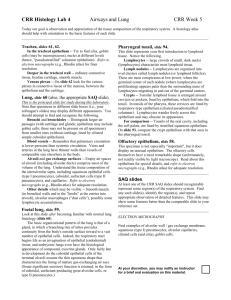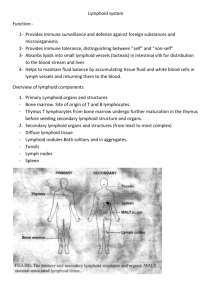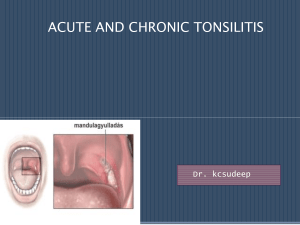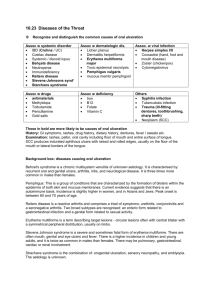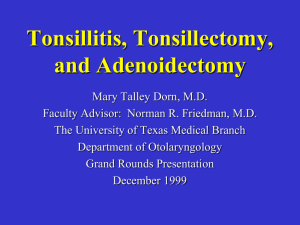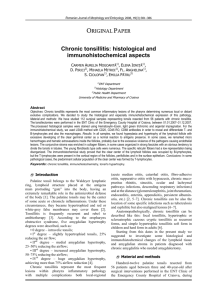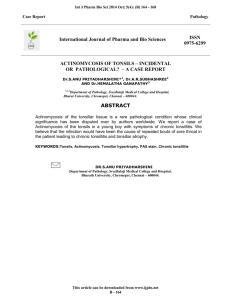contributions to the clinical, histological, histochimical
advertisement
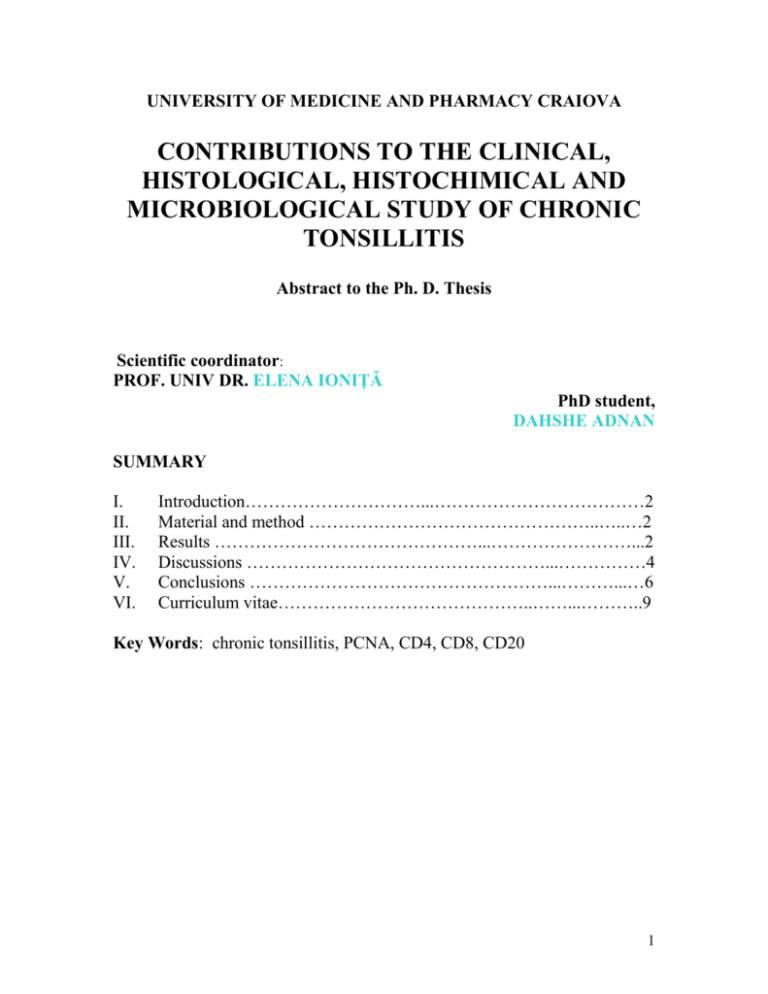
UNIVERSITY OF MEDICINE AND PHARMACY CRAIOVA CONTRIBUTIONS TO THE CLINICAL, HISTOLOGICAL, HISTOCHIMICAL AND MICROBIOLOGICAL STUDY OF CHRONIC TONSILLITIS Abstract to the Ph. D. Thesis Scientific coordinator: PROF. UNIV DR. ELENA IONIŢĂ PhD student, DAHSHE ADNAN SUMMARY I. II. III. IV. V. VI. Introduction…………………………...………………………………2 Material and method …………………………………………..…..…2 Results ………………………………………...……………………...2 Discussions ……………………………………………...……………4 Conclusions ……………………………………………...………...…6 Curriculum vitae……………………………………..……...………..9 Key Words: chronic tonsillitis, PCNA, CD4, CD8, CD20 1 INTRODUCTION Chronic inflammation of the tonsils is one of the most common ENT diseases. Difficulties in identifying the mechanisms involved in the pathophysiology of tonsils has created confusion in formulating accurate conclusions regarding therapy, data from the literature is contradictory over time. MATERIAL AND METHODS Presentation of cases and clinical and laboratory study methods Our study was conducted retrospectively in Emergency Hospital Craiova, Department of Otorhinolaryngology in the period - 2006 -2009 and included a number of 316 patients (174 women and 142 men) with chronic tonsillitistreated with tonsillectomy performed. The following parameters were studied: sex, age, throat swab test, the values of leukocyte blood count, histological, immunohistochemical expression of PCNA, CD4, CD8, CD20, and identification of EBV cytokeratines. Study exclusion criteria were malignant oropharyngeal lesions and the presence of genetic diseases and the inclusion criterion was a diagnosis of chronic or recurrent tonsillitis. Age was not an exclusion criterion. RESULTS The final group consisted of 316 patients, of which 174 were women and 142 were male. Patients were aged between 2-72 years. The average age of patients was 15 years. Distribution of cases by age groups shows a high incidence of damage to two age groups - 11-20 years decades - 62 cases and 31-40 years - 59 cases. Follow closely the number of cases belonging to the decade 21-30 years and 41-50 years - 51 or 52 cases. Duration of symptoms varied between 4 and 36 months with an average of 18 months. Most patients (297 patients) followed antibiotic treatment for this disease in 2 history, but none of them followed such treatment in the weeks prior to the tonsillectomy. The patients described a history of the following symptoms: fever> 37.5 0C to 301 cases, mostly neck pain and often in the cold season - 278 cases, odinophagy - 287 cases of foreign body sensation, burning and / or dryness in the throat - 316 cases, anorexia - 74 cases, dry coughs - 132 cases, halitosis - 197 cases, snoring - 89 cases. To these were added repeated vomiting (13 patients) described only in children, persistent headache (35 cases) and laterocervical adenopathy (17 cases). In patients between 0 and 10 years, physical examination was similar in most patients. They had adenoid facies, mouth breathing and voice twang. Also the majority (56 patients) had fever> 37.50C in history. Of the 74 cases of anorexia, 53 have been described in patients between 6 and 15 years. Halitosis has been described as the most bothersome symptom in 78 of the 197 cases .The only symptom in all patients admitted in the hospital grounds was a foreign body sensation, burning and / or dryness in the throat. Clinical examination revealed the presence of tonsillar lodge volume and color changes of the tonsils. In the 0-10 years age group, 1 patient had hypertrophied tonsils pedunculated. Following paraclinical examination of patients the following results were identified in cultures from pharyngeal exudates seeding: 104 cases beta hemolytic streptococcus, staphylococcus Aureus 38 cases and 44 cases, H. influenzae. In 73 cases the causative agent was viral in 19 cases and was highlighted as the presence of both the agent and the bacterial virus. In 95 cases there was no pathogen isolated. Blood count showed leukocytosis with neutrophilia in 207 cases, leukocytosis with lymphocytosis in 42 cases, leukopenia in 23 cases. In three cases were observed disorders of T lymphocytes, two of whom were diagnosed with tuberculosis and the third with AIDS. Blood examination could not be used to differentiate the viral bacterial infections. ASLO values were above 200ug/ml in 138 cases, of which 104 cases were evident the beta hemolytic Streptococcus in culture. 3 Histopathological study was performed on the entire batch of 316 cases. Immunohistochemical study was conducted on a group of 80 patients. We used markers for B lymphocytes (CD20), T lymphocytes (CD3, CD4, CD8) and CLA (pan antileucocitar antigen) lymphocytes marking surface and crypt epithelium. Squamous epithelium was used for marking a broad spectrum citokeratin - AE1/AE3. As to the immunohistochemistry, we observed intense positive reaction in all cases for CD20 and CLA in lymphocytes from the surface and crypt epithelium and the tonsillar lymphoid tissue.CD20 marks the B cells are present both in the germ centers, which are very numerous and interfolicular. Most B lymphocytes were observed in the follicles and in small numbers in the crypt epithelium and germ centers. Of the 73 cases studied showed intense positivity in CD 20. Distribution of CD3 and CD45RO positive lymphocytes in tonsillar tissue was not uniform. The largest accumulation of T lymphocytes was in the area and in some centers interfoliculare germination. On the surface epithelium, CD3 was negative in most cases , being only a few focal positive lymphocytes in 4 cases.CD4 T cells showed a strong membrane marker. They were distributed either in groups or alone. Their disposition was especially interfoliculary, but also at the periphery of the germinativecenter. In some cases CD4 marked the presence of macrophages from germ centers. CD68 positive macrophages were observed in interfoliculary T lymphocytes regions rich and superjacent crypt epithelium. DISCUSSIONS Chronic tonsillitis is one of the most common diseases of the oral region and is found especially in the younger age groups. This condition is due to chronic inflammation in the tonsils. Data in literature describe as chronic tonsillitis clinical entity defined by the presence of recurrent infections and upper airway obstruction due to increased volume of tonsils. The condition may have systemic repercussions, particularly when complicated, with the presence of recurrent fever, odynophagia, difficult swallowing, halitosis and cervical and submandibular lymphadenopathy. 4 Variability of clinical expression is very high, with cases of repeated infections with systemic repercussions and cases with episodes of fever and pain less, and longer time periods between acute exacerbations. Also, during chronic tonsillitis may vary: many cases are transient, reducing the number and intensity of episodes in time, while others may last throughout life. Chronic tonsillitis immunological deficit has not been fully described. Literature data support the hypothesis of local congenital immunodeficiency, chronic tonsillitis in children because there was an inheritance of the disease, early onset of infections that are frequently opportunistic (anaerobic). (Yilmaz T - 2004). In our study, the inheritance could not be demonstrated because of the history data were not conclusive. Microbiological diagnosis of chronic tonsillitis is the main characteristic of the presence of mixed bacterial flora, but frequently composed of anaerobic organisms. Many saprophytes and pathogens are present in the upper airway, either periodically or continuously (Mary Kurien - 2003). In our cases was observed in cultures of predominantly beta hemolytic Streptococcus. The second most common cause was a virus. The presence of 6% in both cases the agent of the bacterial virus and confirms the theory put forward by Everett (1979) that viral infections may predispose to secondary bacterial infections. One third of the cases studied did not reveal any pathogen agents. During the life tonsils undergoing multiple morphological changes, increasing in size due to hyperplasia of lymphoid follicles of germ centers and histological changes due to the presence of recurrent infections that may be an indication of tonsillectomy. Histological changes in parts of resection are the most common lymphoid hyperplasia. Histopathological study of sections obtained was not limited to examining the lymphoid follicles, the germ centers and crypts, but the entire architecture of the tonsillar tissue, including changes in the surface epithelium was studied. The use of computerized study showed lymphoid follicle growth in germinal center size in patients with chronic tonsillitis. (Gorfien - 1999). 5 Chronic inflammation of the tissue can lead to obstruction of tonsillar crypts due to increased fibrosis. In our study, we have noticed two types of tonsils on fibrosis, pronounced (57.59% of cases) or low (42.41% of cases). The process of sclerosis of the tonsils was shown by increasing the amount of collagen in tonsillar tissue. Unfortunately, the amount of fibrotic tissue in all cases showed an uneven distribution, by subjective assessment. Specimens from which there was a greater extension of fibrous tissue showed a decreased number of CD4 positive lymphocytes. We observed a correlation between lymphocyte subpopulations identified in tonsillar tissue and age groups. CD4 T lymphocytes were identified by Imunomarking higher among older people. The number of CD45RO positive lymphocytes was reduced to 0-10 and 11-20 age groups and increased in others. Marked CD20 B lymphocytes were higher in age groups 0-10, 11-20 and lower at rest. Our data are consistent with those of literature (Rouse RV, 1982) CONCLUSIONS 1. Under inflammatory conditions tonsillar location holds the first place. 2. The age group most affected was 11-20 years followed by decades of 31-40, females 0-10 years and was interested in 54.7% of cases. 3. Clinical symptoms most frequently (over 50% of patients) were dysphagia, tingling in the neck and foreign body sensation, burning and / or dryness in the throat, the latter being the only symptom described by 100% patients. 4. The physical examination revealed hyperemia of the lodge poles palatine tonsil was swollen past and palate previous posts, especially in the upper pole in all cases, the presence of slurry precdum the tonsil crypts, presence of tonsillar microabceses enter in varying proportions. 5. Brodsky-scale distribution of patients, using the ratio between the size of tonsils and oropharynx width between the pillars was previously dominated by those with grade 3. 6 6. By conducting laboratory tests were identified in cultures obtained from seeding exudate beta hemolytic strepococus throat cases 104, which is the etiologic agent with increased frequency. These results were correlated with the amount of ASLO over 200ug/ml made from peripheral blood. In 73 cases the causative agent was viral in 19 cases we highlighted the presence of both bacterial and viral agents. In 95 cases there was no pathogen isolated. 7. Blood count showed leukocytosis with neutrophilia in most cases (207 cases) and leukopenia in 23 cases only. 8. The histopathological study revealed the existence of macroscopic palatine tonsils diameter ranging between 1.2 cm and 4.5 cm that could be separated into two categories: one with large tonsils, low consistency, the presence of small areas on the surface whitish, sometimes hard consistency and the second category, with smaller tonsils, fibrous-looking, whitish color and firm flesh. On the surface section, areas of hemorrhage were noted and, in rare cases of small whitish deposits increased consistency have been identified as tonsilloliths and formations with sizes ranging between 0.3 and 0.5 cm, sessile, called papillomas. 9. As histological diagnosis is not specific to chronic tonsillitis, we sought to describe the microscopic appearance of several parameters: the presence of inflammatory infiltrate in the surface epithelium, the presence of lymphoid hyperplasia, the presence of an increased number of plasma in space and subepitelial interfoliculare areas, the presence of fibrosis, reduced or increased in quantity and present areas of necrosis and bleeding. Reduced inflammatory infiltrate areas of surface epithelium were present in all cases, accompanied in most cases the presence of one or more microabcese. 10. Further changes in the squamous epithelium were: interruption of continuity of layers of epithelial cells, small foci of necrosis and hemorrhage, characteristic ulceration of the surface epithelium and the presence of leukoplakia. In 94 cases described the presence of bacterial colonies in the crypts. 11. All sections obtained showed hypertrophy of lymphoid follicles with prominent germinal centers. There were variations in the extension changes identified in the 7 parenchyma tonsillitis: In 134 cases there were predominance of lymphoid changes and in 182 cases the changes were more intense in the stroma. 12. Conjunctive stroma presented a variable number of collagen fibers that were arranged in bands of different sizes, in 182 cases being a higher degree of fibrosis, and fibrosis in 94 cases was lower. 13. In this study we used immunohistochemical markers for B lymphocytes (CD20), T lymphocytes (CD3, CD4, CD8) and CLA (pan antileucocitar antigen) for marking lymphocyte surface and crypt epithelium and the squamous epithelium was used citokeratine broad spectrum marking - AE1/AE3. 73 cases studied showed intense positive in CD 20. 14. Interfoliculary areas and at some centers the highest germination was observed accumulation of lymphocytes, whereas the surface epithelium, CD3 was negative in most cases, being only a few focal positive lymphocytes in four cases, these issues without advocating for uniform distribution of lymphocytes in tonsillar tissue. CD68 positive macrophages were observed in interfoliculary regions rich in T lymphocytes and superjacent crypt epithelium. All surface epithelial cell layers were AE1/AE3 positive citokeratine. The blood vessels showed a thickening of the muscular layer by actin marking. 15. Regarding systemic infections affecting the tonsils were enrolled four patients, aged between 14 and 67 years who had systemic tuberculosis infection (2 cases), HIV (1 case) and EBV (1 case ). They were further investigated for evidence of the initial infection. 16. Although tonsils diseases were a long time treated superficially, sometimes with radical methods, careful research framework in which they occur and possible complications of tonsillitis converted the disease incorrectly labeled a "minor" in one "major", with correlations in multiple areas of medicine. 8 Curriculum Vitae First name: ADNAN, Last name: DAHSHE Date and place of birth: April 6th, 1971, Saudi Arabia, County of El Taief Nationality: Romanian, Civil status: Married- 3 CHILDREN Education: 1987 - 1998 Admet Shomran Secondary School, Admet Shomran, Bisha county, Saudi Arabia, grade: very good; 1990-1996 University of Medicine and Pharmacy specialization General Medicine, licence average 7,92 (seven 92%); Craiova, 04.01.1999-04.01.2004 Attended and graduated the residency – Ortorhinolaringology; 04.01.2004 Specialist physician ortorhinolaringology, exam general average: 8,41 (eight 41%); From November 2004 Postgraduate, University of Medicine and Pharmacy, ORL specialization, thesis: “Contributions to the clinical, histological, histochimic and microbiologic study of the cronic focal tonsils”. Publication: “Infectii cronice ale amigdalei in asociere cu infectii sistemice” ORL.ro Anul III.Nr.7.2/2010 Experience: 2004-present Specialist physician ORL – Filiasi City Hospital, Dolj County. Foreign Languages: Romanian – very good, Arabic – native, English good 9
